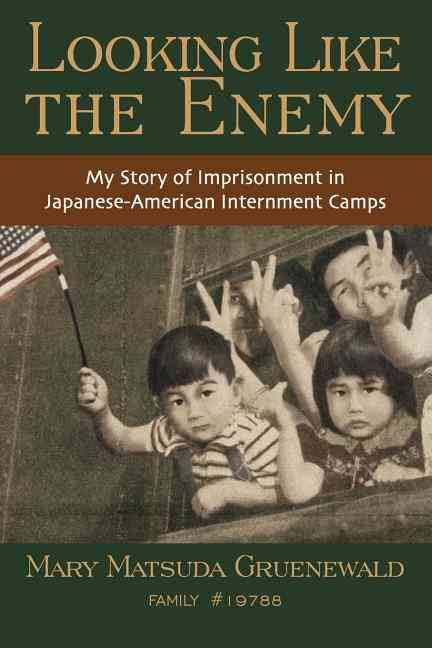Looking Like the Enemy: My Story of Imprisonment in Japanese-American Internment Camps (book)
Creators: Mary Matsuda Gruenewald
Incarceration memoir of life at Pinedale Assembly Center , Tule Lake , and Minidoka , by Mary Matsuda Gruenewald, a seventeen-year-old Nisei at the time of her and her family's forced removal from their Washington state farm. First published in 2005 by NewSage Press, it was followed by a young reader's edition in 2010.
Synopsis
In 1941, sixteen-year-old Mary Matsuda lives a seemingly idyllic life with her Issei parents Heisuke "Harry" Matsuda and Mitsuno Horiye Matsuda and her eighteen-year-old brother Yoneichi on their ten-acre family farm on Vashon Island, Washington. Returning from their Methodist Church one December morning, they learn about the Japanese attack on Pearl Harbor , which quickly changes their lives. Hearing of FBI searches from friends, the family collects and burns all their Japanese possessions. In limbo for several months, they learn they must leave their homes in May of 1942. The family prepares for their exclusion, leaving their farm with a local sheriff to manage, while one of their longtime farmhands operates it. Matsuda provides detailed descriptions of their journey to Seattle, then to their first stop, the Pinedale Assembly Center, outside of Fresno. The family continues on to Tule Lake, then after segregation , to Heart Mountain . Yoneichi eventually is drafted from Heart Mountain, and, after transferring her parents to Minidoka to be nearer to friends from Washington, Mary leaves to join the Cadet Nurse Corps in Iowa. Though the main narrative ends after the family returns home to their farm on Vashon at war's end, two final chapters and an afterword cover Mary's mother's death on the farm in 1965, her first return to Minidoka during a 2004 pilgrimage , and the postwar history of her family.
Looking Like the Enemy includes some of the most detailed accounts of life in the concentration camps—everything from the physical environment to the lack of privacy to the conflicts between inmates from different geographical areas or backgrounds. While covering iconic episodes such as the turmoil over the loyalty questionnaire and the mixed emotions stemming from her brother's induction into the 442nd Regimental Combat Team , Gruenewald also covers some unusual aspects of the story, such her family's mixed experience with the caretakers of their farm (the sheriff cuts off communication and stops paying bills while the family is incarcerated) and her own experience as a Nisei in the Cadet Nurse Corps.
Additional Information
Like many Nisei, Gruenewald didn't talk much about her wartime experiences in the postwar years, telling her children only about some of the fun episodes. But after the Redress Movement , she began writing a camp memoir in 1995 after one of her three children asked about her experiences there. She later joined a writing class run by Brenda Peterson in Seattle in 1999, and by 2002 had decided to write for publication. Looking Like the Enemy was published by NewSage Press in 2005, just in time for Gruenewald's 80th birthday. Five years later, NewSage's founder and publisher Maureen R. Michelson reworked the text to produce a "Young Reader's Edition" that includes glossaries of vocabulary words and of Japanese words and phrases, discussion questions, and writing and research activities for students. In 2012, Gruenewald published Becoming Mama-San: 80 Years of Wisdom for NewSage.
Though of course based on her own experiences, Gruenewald did some additional historical research, particularly on her brother's experiences in the 442nd (he spoke little of his military service and had passed away prior to her having begun her memoir) and on the " No-No Boys ." There are a few minor errors on recounting some of the history: a claim that "[m]any Western states, led by California, had enacted laws prohibiting Japanese arriving from Japan from becoming U.S. citizens" (page 4 of the Young Reader's Edition); applicable laws were federal, not state; a reference to the shooting of James Wakasa in Topaz as having taken place prior to the loyalty questionnaire episode (127; the shooting took place in April 1943); and claiming the the 100th Infantry Battalion "was made up of all Japanese-American volunteers from Hawaii" (185; the 100th included both volunteers and draftees).
Find in the Digital Library of Japanese American Incarceration
Looking Like the Enemy: My Story of Imprisonment in Japanese-American Internment Camps
This item has been made freely available in the Digital Library of Japanese American Incarceration , a collaborative project with Internet Archive .
Might also like
Dandelion Through the Crack/Kiyo's Story
by Kiyo Sato;
Desert Exile
by Yoshiko Uchida;
We the People: A Story of Internment in America
by Mary Tsukamoto
| Author | Mary Matsuda Gruenewald |
|---|---|
| Pages | 227 |
| Publication Date | 2005 |
For More Information
Author website: http://www.lookingliketheenemy.com/ .
Publisher website: http://www.newsagepress.com/lookingliketheenemy.html .
